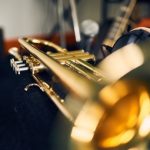WindWorks Trumpet Academy › Forums › WindWorks › Nasty Double Buzz / Upper Lip Shape
- This topic has 10 replies, 4 voices, and was last updated 3 years, 9 months ago by
 Sam Wallace.
Sam Wallace.
-
AuthorPosts
-
-
21 June 2020 at 2:21 am #53668
 Sam WallaceParticipant
Sam WallaceParticipantHi – I’ve been playing for about 6 years now and it has been a constant struggle from the beginning. However much I practice and improve my sound and my playing in general, I can’t seem to shake a nasty double buzz that seems to happen at random. It’s a total gamble every time I pick up the instrument between good sound/range/ease of playing or being unable to produce even a low C without that awful “crackling” sound and feeling like throwing the trumpet.
I’ve reached the brink of quitting (not for the first time) recently and decided to keep going, but I can’t see the point in continuing if I can’t perform due to not knowing whether I can play a note at any given time.
I have an unusually shaped top lip and wonder if it could be part of my problem. If it’s something physical that can’t be overcome, I’d like to find out before I drive myself round the bend… I had an upper lip tie/large gap between my front teeth as a child. The tie was removed before I got braces to remove the gap (about 12 years ago, long before I started playing trumpet). The tie removal surgery was botched, leaving scarring in the center of the inside of my top lip which causes the upper half of my aperture to have an “M” shape when forming an embouchure.
The bump is very noticeable when going “mmmm-ahhh-oooh” – when reducing the aperture size, the shape goes from “M” to something more like a “V” until it almost becomes 3 apertures arranged in a triangle. Using more of a pinched embouchure like I have in the past, there’s a point where the aperture splits into two. When I am getting the double buzz problem, I’m certain that I can feel a difference on my top lip in the area where the bump is.
Here are some pictures of my “oooh”:
If anybody has any thoughts on this I’d be very grateful to hear them – the prospects of quitting altogether vs. carrying on this way seem equally bad at the moment and I’m hoping there is a third option!
P.S. I have been working through the Windworks course for the last few weeks and it has already helped my sound and general ease of playing in many ways, just not on this issue so far as when it happens I am prevented from being able to work on any of the concepts in the first place.
Cheers
Sam -
21 June 2020 at 2:23 am #53669
 Sam WallaceParticipant
Sam WallaceParticipantSorry, the images don’t seem to have worked in my post – here are links instead:
https://imgur.com/6q4H5rw
https://imgur.com/ioqjqVs
https://imgur.com/HmImN9C -
23 June 2020 at 7:00 am #53827
chris.peile
ParticipantHi Sam – I don’t have an answer for you, but can say that I have been struggling with a similar issue. My lip shapes have a bit of what you describem but are certainly different. I’ve found that I can often get a clear note when playing pp, but as I increase volume it splits into the double buzz at some point.
As I have continued practicing, I have found this happens less and less. Whilst it is still a ‘feature’ for me at present, it is certainly reducing. Whilst not an answer – you are not the only one! Hopefully someone with a bit more knowledge/experience may pipe in!
For reference, I have been working through this course for almost 18 months now.
Cheers,
Chris -
23 June 2020 at 4:31 pm #53857
 Ronald CarsonParticipant
Ronald CarsonParticipantI think you are puckering too much, which could be the source of the fuzzy buzz. Producing a smaller aperture is not a matter of puckering like a fish.
These are pictures of my aperture just after playing a note and pulling the horn off my lips. The picture with the bright light was just after playing C above the staff. The other middle might be after playing G above the staff or it could be a C in the staff.
Right after taking the horn off my lips, I’m sure the embouchure and aperture change because the mouthpiece holds the shape a little differently.


-
23 June 2020 at 5:25 pm #53861
 Ronald CarsonParticipant
Ronald CarsonParticipantThis is the aperture after playing a high C (above the staff).
-
23 June 2020 at 8:51 pm #53874
 Sam WallaceParticipant
Sam WallaceParticipantThanks for the replies!
Chris – I also notice the same issue where playing louder can cause the note to split. It’s an odd feeling that I also notice occasionally when trying to slur to the next harmonic; instead of the pitch changing, the volume does and with it comes the double buzz. This only seems to happen on bad days or for part of a day. I have also noticed that when the note splits I can feel air escaping from my nose, presumably a result of pressure change, but I have also wondered if it’s part of the cause. Glad to hear it’s not just me and it’s great that you are improving, I hope that trend continues!
Ronald – Thanks for the feedback and the photos, it’s really interesting to see the difference. Although I may have slightly exaggerated the setting in my photos to show the shape of the upper lip, I have certainly been playing more puckered than you. If I use a similar setting to yours, the protrusion is much less noticeable. This also ties in with Greg’s video about not playing “in the red”. I was possibly taking the “mmm-aah-ooh” thing a bit too far when it is intended just as a tool for establishing the feeling of the corners. I have just spent a bit of time playing with the lips less puckered and although my sound needs a bit of development, it’s more consistent across my range with no double buzzing. I’ll keep at it and see where it leads me. Thanks!
P.S. Here’s my new high C:

-
24 June 2020 at 4:41 am #53895
 Ronald CarsonParticipant
Ronald CarsonParticipantYour lip setting and aperture looks better.
-
24 June 2020 at 9:32 am #53911
 Ronald CarsonParticipant
Ronald CarsonParticipantHi Sam,
Just a couple of things I feel compelled to write. The aperture tends to be smaller on higher notes; however, the air will also affect how large the aperture is. In my examples above, I was playing mezzo-forte or softer. The size of the aperture is going to be affected by air and shape. The shape of the jaw’s position, the tongue’s position, facial muscles, and the aperture corners will vary as the note changes. Our mantra is the lips interact with air as if they were the vocal cords.
-
29 June 2020 at 12:44 am #54298
johnelwood
ParticipantSam,
Sorry to hear you’re having difficulties. Glad to see you received some solid responses above. The only things I could add is that your response to Chris above makes me think you may be using too much air.
One of the crucial things we must teach ourselves to do is separate Air from Shape. Shape determines pitch. Air is for volume and long notes.
In my experience, the best way to separate the two is by focusing on Passively released air–taking a nice full breath (Body Concert Hall “BCH”) then releasing that air into the horn naturally and then observing objectively how changes you make in Shape effect pitch and trying to make minute adjustments to maximize Resonance–the optimum balance of Air and Shape, when efficiency is maximized and our sound is the best.
One visualization that helps me is to focus on the air leaving the aperture and leading with the air–letting the air through the aperture then responding with Shape to the air to obtain the desired pitch.
Another WindWorks member, I’m sorry I forget who, gave the example of visualizing a coffee stirrer / bar straw being held in your lips for higher notes–a small aperture. The better the visualization, the more success they had with a good sound above the staff. This helped me too.
Also, recently, I looked in the mirror and made the smallest aperture I could while still releasing air, then made a larger one like when playing low C and I noticed how little effort it took to make the two different apertures. This helped me while playing avoiding straining while releasing air to produce notes above the staff. Tension is needed at the sides of the embouchure, but not within the top lip / middle part of the lips where the vibrating surface is / where the lips interact with the air–if we engage that part of the lips, it limits their ability to vibrate freely/fast and produce higher vibrations / pitches.
Hope that helps / my $.02 FWIW. Good luck!
-
30 June 2020 at 5:58 am #54408
 Sam WallaceParticipant
Sam WallaceParticipantJohn – Thanks for the feedback.
I often find myself “kicking” and forcing more air when playing higher notes but am starting to move away from that gradually with a new awareness since I began this course. I spend a bit of time each day doing leadpipe exercises to work on shape without engagement from below the head. This doesn’t feel at all how my regular playing does but it is beginning to influence it and things are starting to become easier and more relaxed.
I like your idea of letting the air lead the note and experimenting with the shape only. I will incorporate this into my exercises and see where it leads. I have tried it today and it’s very tricky for me to separate the aperture from everything else, so I definitely need to spend some time on it.
That coffee stirrer visualisation creates a familiar feeling, I associate it with my playing on a good day. Will try to remember that one!
Your suggestion with the mirror aperture exercise makes a lot of sense, if I think of a round aperture I seem to achieve a “rounder” sound and this feels like more engagement from the corners. Another thing to try and remember while playing..
-
-
26 June 2020 at 5:34 am #54028
 Sam WallaceParticipant
Sam WallaceParticipantThanks Ronald! Really appreciate your responses.
There’s a lot to think about simultaneously when making changes, I often find that if I focus on one thing, something else will slip and I will cause myself problems like this. The mantra really helps to focus on the overall feeling of all these factors working in combination.
-
-
AuthorPosts
- You must be logged in to reply to this topic.
Recent topics
-
1.O / 2.0 routine
by
jice.gif
2 months ago -
Abdominal surgery and time off the trumpet
by
DQ
6 months, 3 weeks ago -
Allegro or Presto Practice Routine
by
djm297
7 months, 2 weeks ago -
Tongue lock – Throat lock
by
Ivo Carrabs
8 months ago -
Mouthpiece placement and shape
by
Ivo Carrabs
7 months, 3 weeks ago



